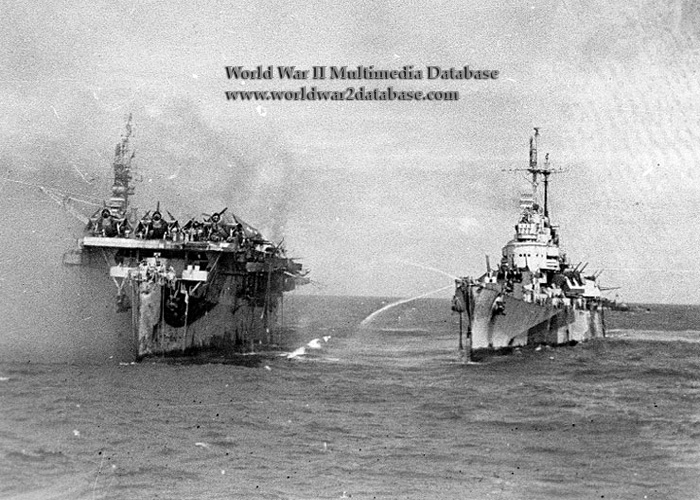| USS Birmingham (CL-62) comes alongside the burning USS Princeton (CVL-23) to assist with fire fighting. At daybreak on October 24, 1944, as Japanese Navy forces were approaching the Philippines from the north and west, Rear Admiral Frederick C. Sherman‘s Task Group 38.3 was operating about more than a hundred miles east of central Luzon. With other elements of Admiral William F. Halsey‘s Third Fleet, TG 38.3 had spent the last several days pounding enemy targets ashore in support of the Leyte invasion operation. This morning Sherman‘s four carriers, Essex, Lexington, Princeton and Langley, had sent off fighters for self-protection and other planes on search missions. Still more aircraft were on deck, ready for attack missions. Though the Japanese had sent out many aircraft to strike the Third Fleet, most were shot down or driven away. However one “Judy“ dive bomber escaped notice and, at 0938 Hours, planted a 250 kilogram bomb on Princeton‘s flight deck, somewhat aft of amidships. It exploded in the crew‘s galley after passing through the hangar, in which were parked six TBM Avengers, each with full gasoline tanks and a torpedo. In its passage, the bomb struck one of these planes, which was almost immediately ablaze. For some reason, the carrier‘s firefighting sprinklers did not activate and the the entire hangar space was quickly engulfed, while smoke penetrated compartments below. Princeton was still underway, but at 1002 a heavy explosion rocked the after part of the hangar. This blast was followed by three more, which heaved up the flight deck, blew out both aircraft elevators and quickly made much of the ship uninhabitable. With all but emergency generator power gone, and much of her crew abandoning ship, Princeton now depended on the light cruisers Birmingham and Reno, plus the destroyers Irwin (DD-794) and Morrison (DD-560), to help fight her fires. While alongside, Morrison‘s superstructure was seriously damage when she became entangled in Princeton‘s projecting structures. After more than three hours‘ work, with the remaining fires almost under control, a report of approaching enemy forces forced the other ships to pull away. By the time they returned Princeton was again burning vigorously, heating a bomb storage space near her after hangar. At 1523, as Birmingham came alongside, these bombs detonated violently, blowing off the carrier‘s stern, showering the cruiser‘s topsides with fragments, and killing hundreds of men. There was now no hope that Princeton could be saved. Her remaining crewmen were taken off and Irwin attempted to scuttle her with torpedoes and gunfire, but with no success. Finally, Reno was called in to finish the job. One of her torpedoes hit near the burning ship‘s forward bomb magazine and USS Princeton disappeared in a tremendous explosion. Princeton was the first U.S. fleet carrier sunk in more than two years, and the last lost during the Pacific War. | |
| Image Filename | wwii1267.jpg |
| Image Size | 201.85 KB |
| Image Dimensions | 700 x 500 |
| Photographer | Unknown |
| Photographer Title | |
| Caption Author | United States Navy Historical Center |
| Date Photographed | October 24, 1944 |
| Location | USS Princeton (CVL-23) |
| City | USS Birmingham (CL-62) and USS Princeton (CVL-23) |
| State or Province | Leyte Gulf |
| Country | Philippines |
| Archive | National Archives and Records Administration |
| Record Number | |
| Status | Caption ©2007, ©2024 MFA Productions LLC Image in the Public Domain |

Author of the World War II Multimedia Database

